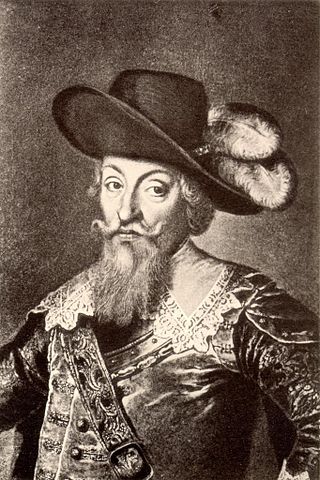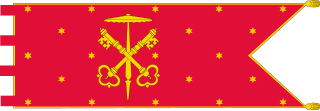
The Battle of Lützen, fought on 6 November 1632, is considered one of the most important battles of the Thirty Years' War. Led by the Swedish king Gustavus Adolphus, an Allied army primarily composed of troops from Sweden, Saxony, and Hesse-Kassel, narrowly defeated an Imperial force under Albrecht von Wallenstein. Both sides suffered heavy casualties, with Gustavus himself among the dead.

Albrecht Wenzel Eusebius von Wallenstein, Duke of Friedland, also von Waldstein, was a Bohemian military leader and statesman who fought on the Catholic side during the Thirty Years' War (1618–1648). His successful martial career made him one of the richest and most influential men in the Holy Roman Empire by the time of his death. Wallenstein became the supreme commander of the armies of the Imperial Army of Holy Roman Emperor Ferdinand II and was a major figure of the Thirty Years' War.

Johann Tserclaes, Count of Tilly was a field marshal who commanded the Catholic League's forces in the Thirty Years' War. From 1620 to 1631, he won an unmatched and demoralizing string of important victories against the Protestants, including White Mountain, Wimpfen, Höchst, Stadtlohn and the Conquest of the Palatinate. He destroyed a Danish army at Lutter and sacked the Protestant city of Magdeburg, which caused the deaths of some 20,000 of the city's inhabitants, both defenders and non-combatants, out of a total population of 25,000.

The Battle of Rain took place on 15 April 1632 near Rain in Bavaria during the Thirty Years' War. It was fought by a Swedish army under Gustavus Adolphus of Sweden, and a Catholic League force led by Johann Tserclaes, Count of Tilly. The battle resulted in a Swedish victory, while Tilly was severely wounded and later died of his injuries.

The Battle of Breitenfeld or First Battle of Breitenfeld, was fought at a crossroads near Breitenfeld approximately 8 km north-west of the walled city of Leipzig on 17 September, or 7 September, 1631. A Swedish-Saxon army led by King Gustavus Adolphus of Sweden and Saxon Elector John George I defeated an Imperial-Catholic League Army led by Generalfeldmarschall Johann Tserclaes, Count of Tilly. It was the Protestants' first major victory of the Thirty Years War.

Ottavio Piccolomini, 1st Duke of Amalfi was an Italian nobleman whose military career included service as a Spanish general and then as a field marshal of the Holy Roman Empire.

Bogislaw XIV was the last Duke of Pomerania. He was also the Lutheran administrator of the Prince-Bishopric of Cammin.

Johann or Hans Georg von Arnim-Boitzenburg was a German Field Marshal. At different times during the Thirty Years' War, he was a Field Marshal for the Holy Roman Empire and its opponent the Electorate of Saxony. He also pursued various diplomatic tasks.

The Battle of the Alte Veste was a significant battle of the Thirty Years' War in which Gustavus Adolphus' attacking forces were defeated by Wallenstein's entrenched troops.
The Polish–Swedish War of 1626–1629 was the fourth stage in a series of conflicts between Sweden and Poland fought in the 17th century. It began in 1626 and ended four years later with the Truce of Altmark and later at Stuhmsdorf with the Treaty of Stuhmsdorf.

The siege of Stralsund was a siege laid on Stralsund by Albrecht von Wallenstein's Imperial Army during the Thirty Years' War, from 13 May 1628 to 4 August 1628. Stralsund was aided by Denmark and Sweden, with considerable Scottish participation. The lifting of the siege ended Wallenstein's series of victories, and contributed to his downfall. The Swedish garrison in Stralsund was the first on German soil in history. The battle marked the de facto entrance of Sweden into the war.

The Treaty of Stettin or Alliance of Stettin was the legal framework for the occupation of the Duchy of Pomerania by the Swedish Empire during the Thirty Years' War. Concluded on 25 August (O.S.) or 4 September 1630 (N.S.), it was predated to 10 July (O.S.) or 20 July 1630 (N.S.), the date of the Swedish Landing. Sweden assumed military control, and used the Pomeranian bridgehead for campaigns into Central and Southern Germany. After the death of the last Pomeranian duke in 1637, forces of the Holy Roman Empire invaded Pomerania to enforce Brandenburg's claims on succession, but they were defeated by Sweden in the ensuing battles. Some of the Pomeranian nobility had changed sides and supported Brandenburg. By the end of the war, the treaty was superseded by the Peace of Westphalia (1648) and the subsequent Treaty of Stettin (1653), when Pomerania was partitioned into a western, Swedish part, and an eastern, Brandenburgian part.

The Banner of the Holy Roman Church was the battle standard of the Papal States during the Renaissance and a symbol of the Catholic Church. The office of the Gonfalonier of the Church was originally intended to function as its bearer of the Holy See.

The capitulation of Franzburg was a treaty providing for the capitulation of the Duchy of Pomerania to the forces of the Holy Roman Empire during the Thirty Years' War. It was signed on 10 November (O.S.) or 20 November (N.S.) 1627 by Bogislaw XIV, Duke of Pomerania, and Hans Georg von Arnim, commander in chief of an occupation force belonging to the army of Ferdinand II, Holy Roman Emperor, led by Albrecht von Wallenstein. While the terms of the capitulation were unfavourable for the Duchy of Pomerania already, occupation became even more burdensome when the occupation force did not adhere to the restrictions outlined in Franzburg. Stralsund resisted with Danish, Swedish and Scottish support, another Danish intervention failed. Imperial occupation lasted until Swedish forces invaded in 1630, and subsequently cleared all of the Duchy of Pomerania of imperial forces until 1631.

The Treaty of Bärwalde, signed on 23 January 1631, was an agreement by France to provide Sweden financial support, following its intervention in the Thirty Years' War.

The Battle of Frankfurt an der Oder on 13 April 1631 took place during the Thirty Years' War. It was fought between the Swedish Empire and the Holy Roman Empire for the strategically important, fortified Oder crossing Frankfurt an der Oder, Brandenburg, Germany.

Philipp von Mansfeld, was Graf von Mansfeld, Vorderort and Bornstedt who commanded troops during the Thirty Years' War. He first fought on the side of the Swedish Empire under his second cousin, was captured, changed allegiance and raised a navy for General Albrecht von Wallenstein. Later, he commanded troops as Feldmarschall of the Holy Roman Empire.
The Diet of Regensburg was a meeting of the Prince-Electors of the Holy Roman Empire which occurred at Regensburg from July to November 1630. It resulted in a major loss of power for the Holy Roman Emperor Ferdinand II.

The Swedish invasion of the Holy Roman Empire or the Swedish Intervention in the Thirty Years' War is a historically accepted division of the Thirty Years' War. It was a military conflict that took place between 1630 and 1635, during the course of the Thirty Years' War. It was a major turning point of the war: the Protestant cause, previously on the verge of defeat, won several major victories and changed the direction of the War. The Habsburg-Catholic coalition, previously in the ascendant, was significantly weakened as a result of the gains the Protestant cause made. It is sometimes considered to be an independent conflict by historians.

Events from the year 1631 in Sweden

















